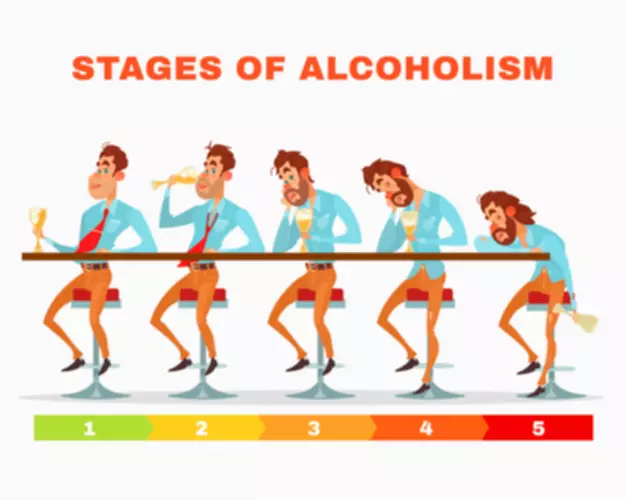Homeless people who misuse alcohol have particular difficulties in engaging mainstream alcohol services, often due to difficulties in attending planned appointments. This section provides an overview of the issues for each special population. Specific guidance applying to special populations will be referred to in the appropriate section in subsequent chapters. The dependence-producing properties of alcohol have been studied extensively in the last 20 years. Alcohol affects a wide range of neurotransmitter systems in the brain, leading to the features of alcohol dependence. The main neurotransmitter systems affected by alcohol are gamma-aminobutyric acid (GABA), glutamate, dopamine and opioid (Nutt, 1999).
Alcohol Use Disorder: From Risk to Diagnosis to Recovery
If you think you might have an alcohol problem, discuss it with a healthcare provider. They can offer advice on how to approach your treatment and assist you with the process of detoxing, withdrawing, and recovering from alcohol use disorder. Everyone’s experience with alcohol is different, but effective treatments are available, whether your condition is mild, moderate, or severe.
How is alcohol dependence treated?
Or a doctor could prescribe drugs to assist with other emotions common in recovery. The harmful use of alcohol can also result in harm to other people, such as family members, friends, co-workers and strangers. Thousands of U.S. deaths per year could be prevented if people followed the government’s dietary guidelines, which advise men to limit themselves to two drinks or fewer per day and women to one drink or fewer per day, Naimi said.
What are resources for treating alcoholism?
Regardless of how the addiction looks, someone typically has an alcohol addiction if they heavily rely on drinking and can’t stay sober for an extended period of time. It can cause changes to the brain and neurochemistry, so a person with an alcohol addiction may not be able to control their actions. WHO emphasizes the development, implementation and evaluation of cost-effective interventions for harmful use of alcohol as well as creating, compiling and disseminating scientific information on alcohol use and dependence, and related health and social consequences. There are gender differences in alcohol-related mortality and morbidity, as well as levels and patterns of alcohol consumption. The percentage of alcohol-attributable deaths among men amounts to 7.7 % of all global deaths compared to 2.6 % of all deaths among women.
How is alcohol withdrawal managed?
With an increasing level of alcohol dependence a return to moderate or ‘controlled’ drinking becomes increasingly difficult (Edwards & Gross, 1976; Schuckit, 2009). Further, for people with significant psychiatric or physical comorbidity (for example, depressive disorder or alcoholic liver disease), abstinence is the appropriate goal. However, hazardous and harmful drinkers, and those with a low level of alcohol dependence, may be able to achieve a goal of moderate alcohol consumption (Raistrick et al., 2006). Where a client has a goal of moderation but the clinician believes there are considerable risks in doing so, the clinician should provide strong advice that abstinence is most appropriate but should not deny the client treatment if the advice is unheeded (Raistrick et al., 2006).
AUDIT has replaced older screening tools such as CAGE but there are many shorter alcohol screening tools,[7] mostly derived from the AUDIT. The Severity of 7 of the best alcohol alternatives to spice up your sobriety Questionnaire (SAD-Q) is a more specific twenty-item inventory for assessing the presence and severity of alcohol dependence. To learn more about alcohol treatment options and search for quality care near you, please visit the NIAAA Alcohol Treatment Navigator.
- Poverty and physical or sexual abuse also increase the odds of developing alcohol dependence.
- His team is collaborating with Mass General’s Research Patient Data Registry to obtain de-identified patient records, which they plan to review for instances of stigmatizing language.
- Some people drink heavily all day, while others binge drink and then stay sober for a while.
- Therefore, it is helpful from a clinical perspective to subdivide dependence into categories of mild, moderate and severe.
- However, for people who are alcohol dependent, brief interventions are less effective and referral to a specialist service is likely to be necessary (Moyer et al., 2002).
The groups for family and friends listed below may be a good starting point. It is important to remember that not all people will respond to medications, but for a subset of individuals, they can be an important tool in overcoming ecstasy mdma. Always consult your healthcare provider to ensure the information displayed on this page applies to your personal circumstances. All of these factors are important in promoting longer term stable recovery. Alcohol dependence is also a category of mental disorder in DSM–IV (APA, 1994), although the criteria are slightly different from those used by ICD–10.
The 2004 ANARP found that only one out of 18 people who were alcohol dependent in the general population accessed treatment per annum. Access varied considerably from one in 12 in the North West to one in 102 in the North East of England (Drummond et al., 2005). In terms of productivity, alcohol contributes to absenteeism, accidents in the workplace and decline in work performance. Up to 17 million working days are lost annually in the UK due to alcohol-related absences and 58,000 working years are lost annually due to premature deaths related to alcohol (Leontaridi, 2003). Alcohol misuse can also lead to job loss and over 38,000 people of working age in England were claiming Incapacity Benefit with a diagnosis of ‘alcoholism’ – nearly 2% of all claimants (Deacon et al., 2007). The term ‘hazardous use’ appeared in the draft version of ICD–10 to indicate a pattern of substance use that increases the risk of harmful consequences for the user.
More recently, however, researchers have been turning their attention to the evaluation of changes in withdrawal symptoms that extend beyond physical signs of withdrawal—that is, to those symptoms that fall within the domain of psychological distress and dysphoria. This new focus is clinically relevant because these symptoms (e.g., anxiety, negative affect, and altered reward set point) may serve as potent instigators driving motivation to drink (Koob and Le Moal 2008). Sensitization resulting from repeated withdrawal cycles and leading to both more severe and more persistent symptoms therefore may constitute a significant motivational factor that underlies increased risk for relapse (Becker 1998, 1999). The prevalence of alcohol-use disorders declines with increasing age, but the rate of detection by health professionals may be underestimated in older people because of a lack of clinical suspicion or misdiagnosis (O’Connell et al., 2003). Nevertheless, the proportion of older people drinking above the government’s recommended levels has recently been increasing in the UK. The proportion of men aged 65 to 74 years who drank more than four units per day in the past week increased from 18 to 30% between 1998 and 2008 (Fuller et al., 2009).
Hospital inpatient and day visits accounted for 44% of these total costs, whilst accident and emergency department visits and ambulance services accounted for 38%. The estimated costs in the workplace amount to some £6.4 billion through lost productivity, absenteeism, alcohol-related sickness and premature deaths (Prime Minister’s Strategy Unit, 2003). The adolescent therefore may continue drinking despite problems, which manifest as difficulties with school attendance, co-morbid behavioural difficulties, peer affiliation and arguments at home. The primary role of specialist treatment is to assist the individual to reduce or stop drinking alcohol in a safe manner (National Treatment Agency for Substance Misuse, 2006). At the initial stages of engagement with specialist services, service users may be ambivalent about changing their drinking behaviour or dealing with their problems.
We usually experience failures along the way, learn from them, and then keep going. When seeking professional help, it is important that you feel respected and understood and that you have a feeling of trust that this person, group, or organization can help you. Remember, though, how long does weed stay in your system that relationships with doctors, therapists, and other health professionals can take time to develop. Due to the anonymous nature of mutual-support groups, it is difficult for researchers to determine their success rates compared with those led by health professionals.
What’s most important is looking at your drinking habits and finding a way to cut back that works for you. From month-long sobriety challenges to the Sober Curious movement, more and more people are taking a closer look at the role alcohol plays in their lives. All approved medications are non-addictive and can be used alone or in combination with other forms of treatment. Ultimately, there is no one-size-fits-all solution, and what may work for one person may not be a good fit for someone else.
There are two major differences between alcohol dependence and alcoholism as generally accepted by the medical community. Mutual-support groups provide peer support for stopping or reducing drinking. Group meetings are available in most communities at low or no cost, and at convenient times and locations—including an increasing presence online. This means they can be especially helpful to individuals at risk for relapse to drinking. Combined with medications and behavioral treatment provided by health care professionals, mutual-support groups can offer a valuable added layer of support. People who are alcohol dependent are often unable to take care of their health during drinking periods and are at high risk of developing a wide range of health problems because of their drinking (Rehm et al., 2003).
A meta-analysis of 9,897 twin pairs from Australian and US studies found the heritability of alcohol dependence to be in excess of 50% (Goldman et al., 2005). However, a meta-analysis of 50 family, twin and adoption studies showed the heritability of alcohol misuse to be at most 30 to 36% (Walters, 2002). Whatever the true heritability, these studies indicate that genetic factors may explain only part of the aetiology of alcohol dependence. The remaining variation is accounted for by environmental factors and their interaction with genetic factors. While no single gene for alcohol dependence has so far been identified, a range of genes that determine brain function have been implicated (Agrawal et al., 2008).
A UK study found 26% of community mental health team patients were hazardous or harmful drinkers and 9% were alcohol dependent (Weaver et al., 2003). In the same study examining patients attending specialist alcohol treatment services, overall 85% had a psychiatric disorder in addition to alcohol dependence. Eighty-one per cent had an affective and/or anxiety disorder (severe depression, 34%; mild depression, 47%; anxiety, 32%), 53% had a personality disorder and 19% had a psychotic disorder. Although psychiatric comorbidity is common in people seeking help for alcohol-use disorders, this will usually resolve within a few weeks of abstinence from alcohol without formal psychiatric intervention (Petrakis et al., 2002).…



